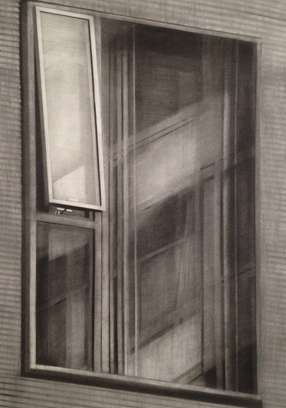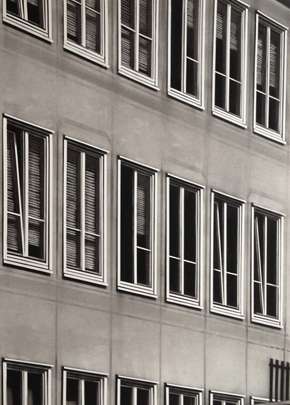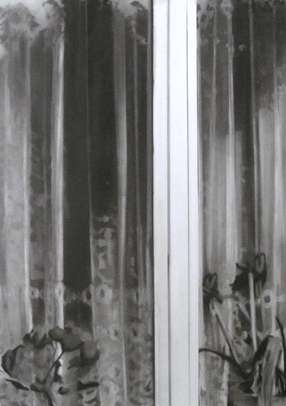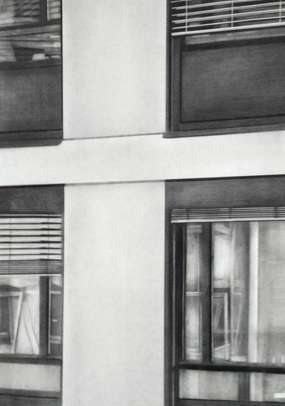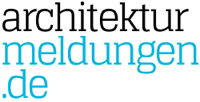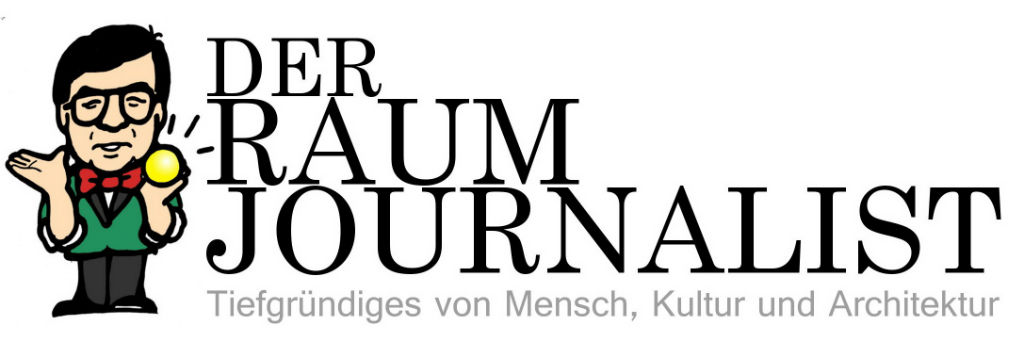“Windows are metaphors for seeing, windows are like drawings of a building.” INTERVIEW with Rik De Boe
Belgian artist Rik De Boe (*1964) specializes in black and white charcoal drawings, on identical paper sizes. Many of his works are based on photographic sketches, taken on the road. Back in the studio, De Boe uses these shots as starting points for his drawings. His basic interest is space and architecture – he captures windows, blinds or sections of facades in high-precision drawings.
At the same time his works always revolve around fundamental questions of perception, as if they were snapshots of a continuing exploration of space, which is accompanied by a constant change of scale and perspective.
Rik de Boe is teaching drawing and graphics at the art academy in Brussels and is artistic leader of Voorkamer, an art space dedicated to contemporary art in Lier, which he founded in 1996, together with Peter Morrens. He is represented by Rasche Ripken Berlin and Gallery Sofie Van de Velde Antwerpen.
In an email interview with deconarch.com Rik De Boe tells us about his particular interest in windows, why his sceneries are deserted and lets us delve into his working process.
all illus. (c) Rik De Boe,
www.rikdeboe.be
and Galerie Rasche Ripken,
www.rasche-ripken.de
INTERVIEW
What is it that interests you about architecture? And why the particular focus on windows?
Architecture surrounds us everywhere. I’ll try to make drawings based on what I have seen, what I have experienced. Everything is seen in a certain way, as found images or as real items. Windows are metaphors for seeing, windows are like drawings of a building.
Every window is specific, tells us something – not a big story, but something small that becomes visible to the outside.
The drawings are deserted, no inhabitants there. Why?
A nice quote from Andrew Grassie says: ”People are too interesting“.
The viewer is the actor. My window views are my personages. In some recent drawings people are appearing, fragments of people. Most of them are coming from paintings, in the Vermeer series for example.
The only good answer I can give is … because it’s what I do.
”People are too interesting“ – do you agree with Grassie?
It is quite an ironic quote. Rather I like the idea that my drawings suggest a world where people are hidden, sleeping … maybe they are dead or they just left the building? It is not really a happy world that is portraited.
The reflection of the glass in the frames is playing this role, as it disturbs our view of the image and thus you become part of it. In other drawings light reflections play a role, too. Where there is a light, there is a suggestion of people, of life …
Tell us a little more about your work – what are you interested in?
Let me tell you some quotes I consider relevant.
“Re-enacting my own life.”
“The movement of my thought interests me more than the thought itself.” (Pablo Picasso)
“Let’s just imitate the real, until we find a better one.“ (The Notwist)
Maybe I’m looking for images that evoke a similar feeling as if you come home from a long trip abroad and the world that you so trust beholds. I love that strange feeling.
There is no action … point back to an act that has just passed, or an action that is still to come. The props are so meaningful. They have the potential of a story.
So you are ”collecting“ props, you isolate them and transform them into a canvas where a story develops?
The props are blocking the view, vases, flowerpots, reflections … These things act as a reminder of the inhabitants. They let you think about people without seeing them.
But I don’t want to tell a story, because it ends as quickly as it starts.
Where do you find your motives?
Everywhere.
By passing by things, during walks, travelling, museum visits, photographing – not really in a conscious way, sideways and a bit in a hurry, maybe almost uninterested.
A lot of drawing are views seen in an backwards angle – as I am passing things and looking back while walking forwards. When you are seeing something but become aware of it only a fraction later.
Later in the studio the photographs need to rest, and some of them come to my attention when they are ready and worth to become drawings.
How is your working process?
I start by protecting all white areas with sensitive pink tape. Then I draw the most black areas with concentrated charcoal. Working with fingertips and brushes stage after stage, I remove the tape or protected areas between different phases while fixating the drawing with fixative. I continuously move to the white area lifting off the attached tapes, often leaving marks. In the end the paper – and drawing – shows the proces, the history of the making.
Why painting/drawing these sceneries, why not just photographing them?
I am more interested in a tonality which suggests a photocopy rather than a photo or even a drawing.
A drawing is slower.
What possiblities does this offer?
Developing something in time with errors, doubts and hesitations. The drawings can even appear more real than reality to me, almost as if a world could exist in black and white …
Why art?
“Art is what makes life more interesting than art.” (Robert Filliou)
Are there role models, influences, … which inspire your work?
I like Vermeer, Piero della francesca, Frank Zappa, Georges Perec, Gustave Flaubert, Bach, Palladio, Italia, Domenico Gnoli, Edward Hopper, Leon Spilliaert, Luc Tuymans, John Coltrane, Joey Baron, Andreas Gursky, Peter Zumthors Vals, Breaking Bad, Piet Mondriaan, Miroslav Tichy, James Stewart, Hitchock, Cary Grant, New York, Japan, PJ Harvey, Captain Beefheart, Gerhard Richter, Hall Hartley, Morandi, Andrea Mantegna, Markus Raetz, Bas Jan Ader, RenĂ© Daniels, Mies Van Der Rohe, Gerrit Rietveld, Mad Men, The Brancaci Chapel, Giotto, Led Zeppelin, Orval Beer, Jacques Tati, Jim Jarmusch Stranger than paradise, Villa Sunflower Marcelisse, Katsura Imperial Villa, Doris Day, Bruce Nauman, MichaĂ«l Borremans, John Zorn Massada, Roman Signer, Kolumba Köln, Hercules Seghers, Saul Leiter, Johan De Wilde, Fred Astaire, Caspar David Friedrich, Thomas Huber, Ellsworth Kelley, Agnes Martin, Balthus, Hammershoi Vilhelm, Ed Ruscha, Sigmar Polke, Dirk Braeckman, Fra Angelico, Rogier van der Weyden, Van Eyck, Hiroshi Sugimoto, Karl Blossfeldt, Robert Bresson, Laurel and Hardy, Steve McQueen, Bill Viola, Sonic Youth, Miles Davis …
Rik De Boe, thank you for sharing your thoughts!

